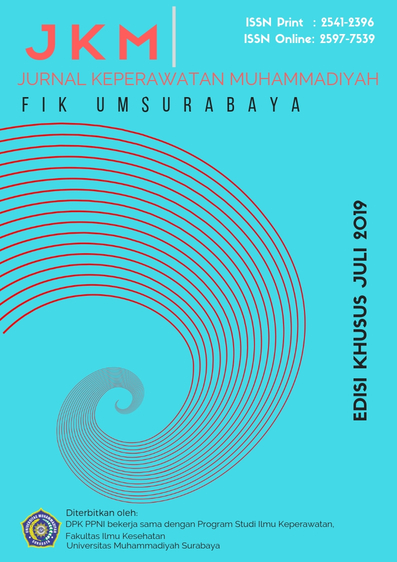Efektifitas Penerapan Self Efikasi Terhadap Profil Lipid Pada Penderita Hiperlipidemia
DOI:
https://doi.org/10.30651/jkm.v4i2.1904Keywords:
Self Efikasi, Profil Lipid, HiperlipidemiaAbstract
Background: Hyperlipidemia is one of the risk factors for atherosclerosis, which can cause coronary heart disease and stroke. To prevent this from happening, it is essential to detect early the level of lipid profile in human blood which includes Total Cholesterol (C-Total), High-Density Lipoprotein (HDL), Low-Density Lipoprotein (LDL), and Triglycerides (TG). Furthermore, one of the ways to control the cholesterol levels is by applying self-efficacy. In this respect, self-efficacy assessment was carried out by using a questionnaire called the Exercise Self-Efficacy Scale (ESES) and the Cardiac Diet Self-Efficacy Scale (CDSES). The purpose of this literature review is to describe the effectiveness of self-efficacy on lipid profile in hyperlipidemic patients.
Method: The literature review was gained from Pubmed, ProQuest, Google Scholar, and secondary literature search.
Result: There were 37 articles identified and published from 2012-2018. Of the 37 articles, there were 7 articles that met the inclusion criteria. As a result, these seven articles show that the application of self-efficacy is able to improve the patients' self-confidence.
Conclusion: The application of self-efficacy is able to help nurses increase the patients' self-confidence. In addition, self-efficacy assessment can be performed by using self-efficacy instruments in an effort to control the lipid profile of hyperlipidemic patients.
Keywords: Self-efficacy, Lipid Profile, Hyperlipidemia
References
Anwar, T. (2017). Dislipidemia Sebagai Faktor Risiko Penyakit Jantung Koroner. Retrieved from https://www.researchgate.net/publication/42321431
Arsana, P. M., Rosandi, R., & Manaf, A. (2015). Panduan Pengelolaan Dislipidemia di Indonesia. Jakarta: PB PERKENI.
Barrios, V., Escobar, C., Francesco, A., Cicero, G., Burke, D., Fasching, P., … Bruckert, E. (2016). A nutraceutical approach ( Armolipid Plus ) to reduce total and LDL cholesterol in individuals with mild to moderate dyslipidemia : Review of the clinical evidence. Atherosclerosis Supplements. https://doi.org/10.1016/j.atherosclerosissup.2016.10.003
Combs, G., & Luthans, F. (2007). Diversity Training : Analysis of the Impact of Self- Efficacy Diversity Training : Analysis of the Impact of Self-Efficacy. https://doi.org/10.1002/hrdq.1193
Dalimartha, S., & Dalimartha, F. A. (2014). Tumbuhan Sakti Atasi Kolesterol. Jakarta: Plus Pengobatan.
Hatma, R. Dj. (2012). Sosial Determinan dan Faktor Risiko Kardiovaskular (Analisa Data Sekunder Riskesdas 2007). Buletin Jendela Data Dan Informasi Kesehatan, 2.
Izumi, H., Mastubara, M., Saeki, K., Imuta, H., & Mori, M. (2014). The Effectiveness of Hyperlipidemia Prevention Intervention Designed to Affect Behavior Change : Focus on Changes in Health Behavior, (December), 962–970.
Liu, W. (2015). The Self-Efficacy for Functional Abilities Scale for Older Adults in Long-Term Care: Two-Level Exploratory and Confirmatory Factor Analysis, 23(1), 112–126.
Olander, E. K., Fletcher, H., Williams, S., Atkinson, L., Turner, A., & French, D. P. (2013). What are the most effective techniques in changing obese individuals ’ physical activity self-efficacy and behaviour : a systematic review and meta-analysis, 1–15.
Peterson, S. J., & Bredow, T. S. (2013). Middle Range Theories : Application to Nursing research (3rd ed.). Philadelphia: Wolters Kluwer Health| Lippincott Williams & Wilkins.
Pionas. (2015). 2.10 Hipolipidemik » 2.10.4 Statin. Retrieved from http://pionas.pom.go.id/ioni/bab-2-sistem-kardiovaskuler-0/210-hipolipidemik/2104-statin
Qin, S., Huang, L., Gong, J., Shen, S., Huang, J., Ren, H., & Hu, H. (2017). Efficacy and safety of turmeric and curcumin in lowering blood lipid levels in patients with cardiovascular risk factors : a meta-analysis of randomized controlled trials, 1–10. https://doi.org/10.1186/s12937-017-0293-y
Rajati, F., Sadeghi, M., Feizi, A., Sharifirad, G., Hasandokht, T., & Mostafavi, F. (2014). Self-efficacy strategies to improve exercise in patients with heart failure: A systematic review, 10(6), 319–333.
Smith, M. J., & Liehr, P. R. (2014). Middle range theory for nursing (Third). New York: Springer Publising Company.
Wahyuni, A., & Rezkiki, F. (2015). Pemberdayaan dan Efikasi Diri Pasien Penyakit Jantung Koroner Melalui Edukasi Kesehatan Terstruktur. Jurnal Ipteks Terapan Research of Applied Science and Education V9.i1 (28-39) Kopertis Wilayah X 28 ISSN: 1979-9292 E-ISSN: 2460-5611, 1, 28–39.
Walpole, B., Dettmer, E., Morrongiello, B. A., Mccrindle, B. W., & Hamilton, J. (2013). Motivational Interviewing to Enhance Self-Efficacy and Promote Weight Loss in Overweight and Obese Adolescents : A Randomized Controlled Trial, 38(9), 944–953.
Downloads
Published
Issue
Section
License
- Penulis tetap memegang hak atas karyanya dan memberikan hak publikasi pertama kepada jurnal ini yang secara simultan karya tersebut dilisensikan di bawah:Â Creative Commons Attribution-ShareAlike 4.0 International (CC BY-SA 4.0)













